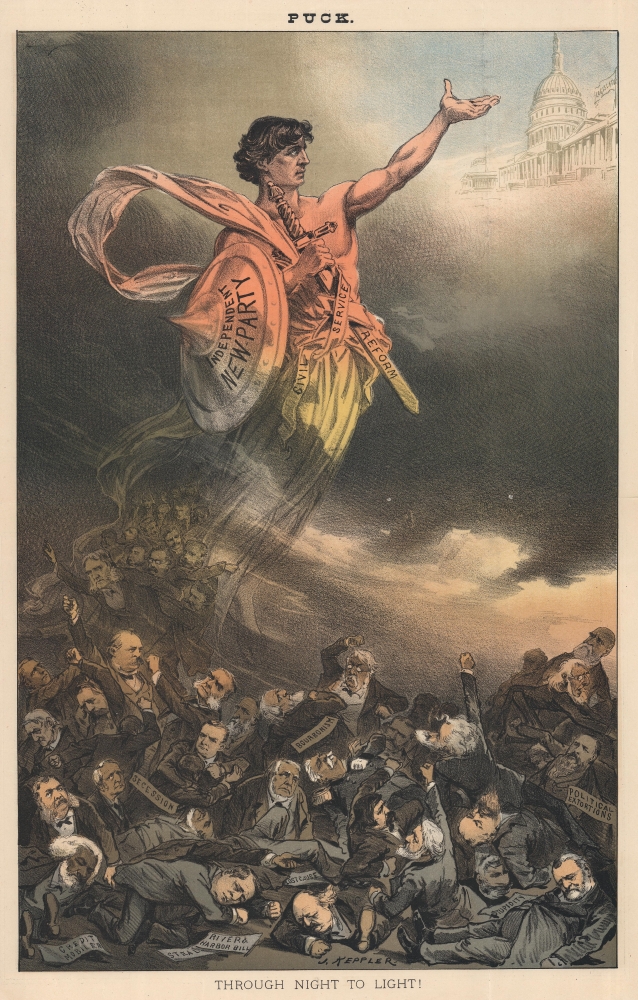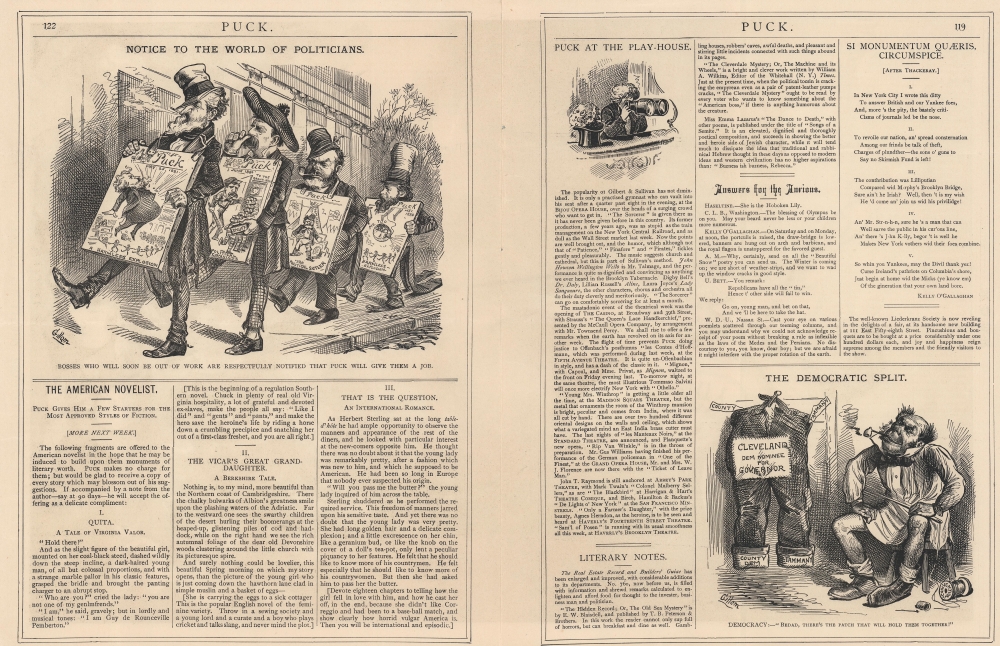This item has been sold, but you can get on the Waitlist to be notified if another example becomes available, or purchase a digital scan.
1882 Keppler Political Cartoon Promoting a Third Party and Civil Service Reform
ThroughNight-keppler-1882
Title
1882 (undated) 19.25 x 12 in (48.895 x 30.48 cm)
Description
A Closer Look
A spectral figure rises above the fracas and infighting in Congress with an outstretched hand toward the U.S. Capitol (labeled Legislature). The figure carries a shield labeled 'Independent New Party' and a sword wrapped in a ribbon labeled 'Civil Service Reform'. Below, politicians brawl in smoke and fog, with issues such as 'Secession', 'Bourbonism', 'Political Extortions', 'Credit Mobilier', and 'Lost Cause' floating amongst them. Many of these figures would have been recognizable to a contemporary audience: former President Ulysses S. Grant, current President Chester A. Arthur, Frederick Douglass, and future president William Howard Taft.A Little More Analysis
According to Samuel J. Thomas's article 'Holding the Tiger: Mugwump Cartoonists and Tammany Hall in Gilded Age New York' (with the Tiger in question being Tammany Hall and all its related corruption), Puck introduced a personification of their desire for greater non-partisanship in government in the summer of 1882. A robust young man, he symbolized Puck's editorial hopes for a new Independent Party. The figure is based on a 19th century German caricature of the 16th century legend of Michael the Brave, a Romanian prince and conqueror.Chromolithography
Chromolithography, sometimes called oleography, is a color lithographic technique developed in the mid-19th century. The process involved using multiple lithographic stones, one for each color, to yield a rich composite effect. Oftentimes, the process would start with a black basecoat upon which subsequent colors were layered. Some chromolithographs used 30 or more separate lithographic stones to achieve the desired product. Chromolithograph color could also be effectively blended for even more dramatic results. The process became extremely popular in the late 19th and early 20th centuries when it emerged as the dominant method of color printing. The vivid color chromolithography produced made it exceptionally effective for advertising and propaganda imagery.Publication History and Census
This political cartoon was drawn by Joseph Keppler and published in the October 25, 1882, issue of Puck Magazine. Although widely published, specific issues of Puck are scarce and hard to find on the private market. They are also poorly cataloged in institutional collections, so it is difficult to know how many of each issue survive. The present cartoon does not appear to be digitized and we have found no catalog records for the cartoon or the issue of Puck.Cartographer
Joseph Ferdinand Keppler (February 1, 1838 - February 19, 1894) was an immensely influential Austrian-born American caricaturist and cartoonist. Born in Vienna, Keppler studied art at the Academy of Fine Arts Vienna and contributed work to the Vienna-based comedy magazine Kikeriki. As he was unable to support himself only with his art, Keppler joined a theatrical troupe and acted as its scene painter and then as a comedian. He earned some extra money as the troupe traveled through the Tyrol and Italy by restoring old paintings in monasteries. He married Viennese actress Minna Rubens in 1864 and he and his wife soon emigrated to the United States to join Keppler's father, who had emigrated to the United States to escape the Revolutions of 1848 and was the proprietor of a general store in northern Missouri. By 1867, Keppler and his wife had settled in St. Louis, where Keppler was working as an actor. He helped start the German-American cartoon weekly Die Vehme in 1869. Die Vehme survived for a year, and was followed by Frank und Frei, which lasted only six months. Keppler founded Puck in St. Louis in March 1871, though this iteration of the magazine only lasted until August 1872. Minna died in 1870, and Keppler married Pauline Pfau in 1871, with whom he had three children. Keppler and his wife moved to New York City in 1872, where he found work in Frank Leslie's publishing house, and Keppler began contributing cartoons to Frank Leslie's Illustrated Newspaper in 1874. Puck was restarted by Keppler and fellow Frank Leslie employee Adolph Schwarzmann in September 1876 for the German-American population in New York, and began printing an English-language edition the following year. Keppler's cartoons, particularly those criticizing President Ulysses S. Grant and his administration, began to generate attention and publicity for the magazine. Keppler's caustic wit and clever adaptations of classical and historical subjects became famous, as did their pioneering use of color lithography. Keppler published a special World's Fair Puck from the World's Columbian Exposition in Chicago during the summer of 1893, a strain that took a terrible toll on his health, and contributed to his death the following year in New York. More by this mapmaker...




